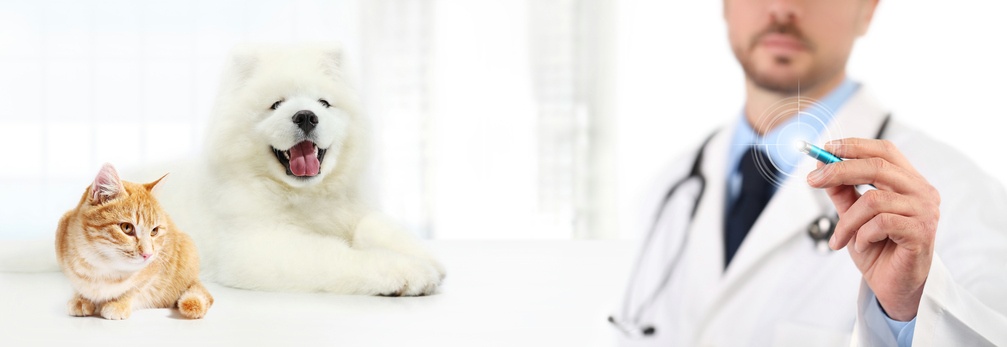
Veterinary medicine has experienced extraordinary advancements and growth since its early stages in known ancient history — taking place in Mongolia more than 3,000 years ago. An increase in consumer demand, along with modern-day technologies unfathomable to the Mongolian nomadic herders of 1300-700 B.C., have revolutionized animal healthcare. Veterinarians working in today’s rapidly changing veterinary industry must remain informed on the latest trends, breakthroughs and approaches to remain competitive. Here are five trends to watch in 2018 and beyond.
Telehealth
Telemedicine
“Telehealth is the overarching term that encompasses all uses of technology geared to the remote delivery of health information or education,” the Veterinary Team stated in its November/December 2017 brief. Telemedicine, a subcategory of telehealth, refers to direct communication between veterinarians and clients via phone, email, or video conferencing technologies.
Recent technologies have propelled this old concept forward. A growing number of consumers not only prefer healthcare providers that offer telemedicine services but consider it a necessity. Due to increased use and awareness, demand for telemedicine within the veterinary industry is rising.
This demand is fueled by:
- Consumer interest in technology and personalized customer service
- Consumers who genuinely want to provide quality care for companion animals, but cannot attend appointments due to busy schedules
- Clients with senior animals
- Individuals without reliable transportation
- Clients with companion animals in need of frequent checkups whose journey to the veterinary office is stressful for both clients and patients
Currently, the veterinary industry is not meeting consumer demand. According to veterinary business specialist Ed Blach, DVM, MBA, “40 percent of veterinarians do not answer client questions by phone,” and “instead ask clients to come in to the clinic.” In addition, 85 percent of animal guardians find that “the connection to a veterinarian via telehealth is appealing,” however, “70 percent of veterinarians are unlikely to offer any telehealth service in the near future.”
Telemedicine is a useful tool to improve existing veterinarian-client-patient relationships (VCPR) and document patient health. Even so, veterinarians must acknowledge its limitations such as inaccuracy in telemedicine exams.
Teleconsultations
Teleconsultations, defined as “veterinarian-to-veterinarian communications on diagnostic interpretation, interventional therapy or treatment planning,” are becoming more prevalent within veterinary medicine. Through this method, veterinary specialists review and interpret medical records produced by the primary care veterinarian (PCV) and offer professional recommendations to the PVC remotely. This provides clients and patients with greater access to veterinary specialists regardless of geographic location. For example, veterinarians who maintain a working relationship with a teleconsulting veterinary nutrition specialist can deliver expert care to patients having specialized nutrition needs. Depending on location, a PCV’s clients may have the ability to attend in-person appointments with a teleconsulting provider after a trusting relationship is formed via the PCV.

Wearables
Currently a niche market, the popularity of wearable technologies is predicted to grow. Not only will more consumers purchase collars with cameras and GPS trackers, but animal guardians will also see electronic collars that monitor an animal’s activity levels, body temperature, heart rate, food intake, and other measurements as a necessity. These devices transmit and store data through an app and web portal. Access to the database allows animal guardians to catch small changes in an animal’s behavior that would otherwise go unnoticed while allowing veterinarians to monitor patient health remotely.
The Human-Animal Bond
According to Consultancy EY-Parthenon, 72 percent of consumers consider companion animals as family members. In particular, many Millennials, who account for 35 percent of all animal guardians in the U.S., are delaying or opting out of parenthood and choosing to share their homes with companion animals. As the human-animal bond continues to grow among consumers and their companion animals, there is an increased desire for veterinarians who show understanding and support for this relationship.
In February 2018, the Human Animal Bond Research Institute (HABRI) and the North American Veterinary Community (NAVC) launched the Human-Animal Bond Certification program, representing the rising demand for this approach. Available to practicing veterinarians, veterinary nurses, and veterinary practice managers, the certification covers the health benefits of human-companion-animal interaction and discusses how to best incorporate this knowledge into everyday practice.
Veterinary Industry Fees and Pricing
U.S. consumers collectively spent $69.51 billion on companion animals in 2017 with spending estimated to reach $72.13 in 2018, according to the American Pet Products Association (APPA). For veterinary care, U.S. consumers spent $17.07 billion in 2017, and will most likely spend $18.26 billion in 2018. Despite this increase, many consumers continue to struggle financially.
Financial stress among consumers presents challenges for veterinary businesses to continue to raise prices. As a result, many businesses experience a decline in clients and visits when prices are raised. Focusing on providing quality care to patients, determining ways to cut operational costs, providing preventative care plans, and implementing payment plans are key strategies for today’s veterinary businesses to succeed.
Payment Plans
Continual innovation presents ample opportunities for business improvements within the veterinary industry. From incorporating the latest telemedicine technologies to offering top payment plan services to clients, informed businesses can provide exceptional care to patients, maintain positive relationships with consumers, retain clients, and increase sales volume.
As a leading payments guarantee company, CrossCheck provides check processing services to U.S. veterinary businesses that help merchants increase sales while reducing risk. Ideal for larger payments, our Multiple Check program allows clients additional time to fund veterinary care without using or applying for credit. Clients write 2 – 4 check that are deposited by merchants over a 30-day period.
Businesses can confidently accept checks with guaranteed funding of each deposit on all approved checks. By implementing Multiple Check, businesses can continue to care for patients while improving client satisfaction. Learn more by downloading our free guide.



